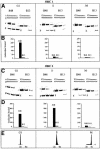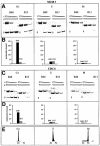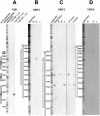Localization of proteins bound to a replication origin of human DNA along the cell cycle
- PMID: 12912926
- PMCID: PMC175794
- DOI: 10.1093/emboj/cdg404
Localization of proteins bound to a replication origin of human DNA along the cell cycle
Abstract
The proteins bound in vivo at the human lamin B2 DNA replication origin and their precise sites of binding were investigated along the cell cycle utilizing two novel procedures based on immunoprecipitation following UV irradiation with a pulsed laser light source. In G(1), the pre-replicative complex contains CDC6, MCM3, ORC1 and ORC2 proteins; of these, the post-replicative complex in S phase contains only ORC2; in M phase none of them are bound. The precise nucleotide of binding was identified for the two ORC and the CDC6 proteins near the start sites for leading-strand synthesis; the transition from the pre- to the post-replicative complex is accompanied by a 17 bp displacement of the ORC2 protein towards the start site.
Figures







References
-
- Abdurashidova G., Deganuto,M., Klima,R., Riva,S., Biamonti,G., Giacca,M. and Falaschi,A. (2000) Start sites of bidirectional DNA synthesis at the human lamin B2 origin. Science, 287, 2023–2026. - PubMed
-
- Aparicio O.M., Weinstein,D.M. and Bell,S.P. (1997) Components and dynamics of DNA replication complexes in S.cerevisiae: redistribution of MCM proteins and Cdc45p during S phase. Cell, 91, 59–69. - PubMed
-
- Bell S.P. and Stillman,B. (1992) ATP-dependent recognition of eukaryotic origins of DNA replication by a multiprotein complex. Nature, 357, 128–134. - PubMed
Publication types
MeSH terms
Substances
LinkOut - more resources
Full Text Sources
Other Literature Sources

